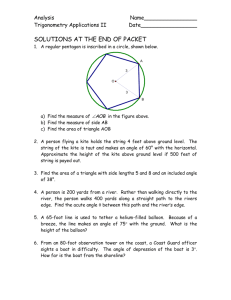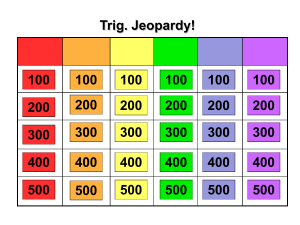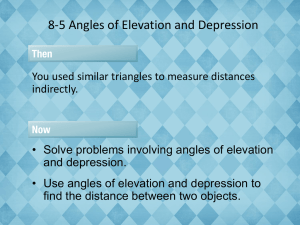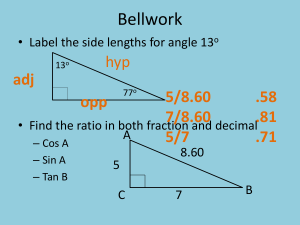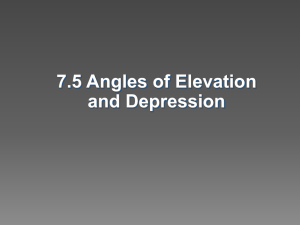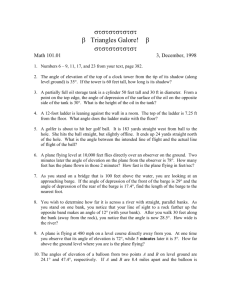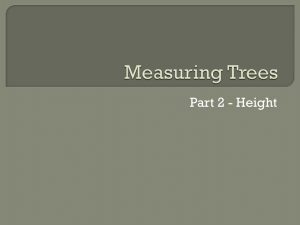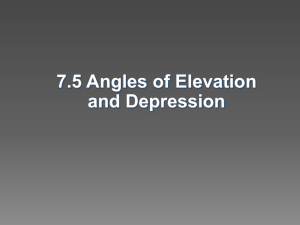8.7 Applications of Right Triangle Trigonometry
advertisement
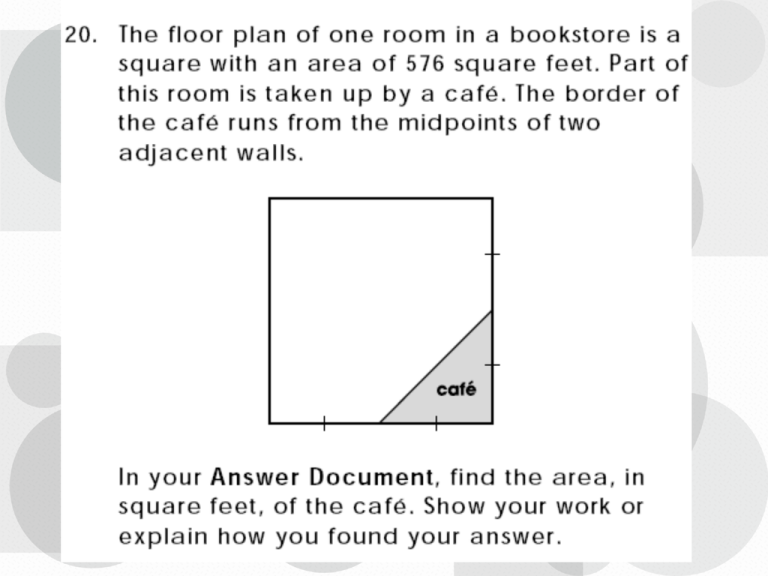
8.7 APPLICATIONS OF RIGHT TRIANGLE TRIGONOMETRY Some critical terminology Horizontal any line constructed so that it is parallel with the horizon or another horizontal line. Line of Sight the line from the observer’s eye to the object Angle of Elevation if the object being observed is above the horizontal then the angle between the line of sight and the horizontal is called the Angle of Elevation. Angle of Depression if the object being observed is below the horizontal then the angle between the line of sight and the horizontal is called the Angle of Depression. Angle of Inclination if the line of sight follows a physical object, such as an inclined plane or a hillside, we use the term Angle of Inclination. Diagram of terminology. Angle of Depression Horizontal Horizontal Angle of Elevation The hardest part of these story problems is drawing the picture and deciding what you are being asked to find. An observer on the 1st floor of an airport control tower sights an airplane at an angle of elevation of 32◦. The pilot reports the plane’s altitude is 3.5 km. What is the plane’s horizontal ground distance from the tower? A helicopter pilot sights a life raft. The angle of depression is 26° and the helicopter’s altitude is 3km. What is the plane’s distance from the raft? A monument casts a shadow 215 ft long when the angle of elevation of the sun is 52°. Find the height of the monument. The length of a guywire supporting a radio tower is 175 ft. The angle of elevation created by the guywire and ground is 65°. How tall is the tower? The tailgate of a moving van is 3.5 feet above the ground. A loading ramp is attached to the rear of the van at an incline of 10°. Find the length of the ramp. Oscar is in a lighthouse on a cliff. He observes 2 sailboats due east of the lighthouse. The angles of depression to the 2 boats are 33° and 57 °. Find the distance between the 2 sailboats if the top of the lighthouse measures 803 feet from sea level. A pilot is flying at 10,000 feet and wants to take the plane up to an altitude of 20,000 feet over the next 50 miles. What should his angle of elevation be to accomplish this task? Two observers are 200 feet apart, in line with a tree containing a bird’s nest. The angles of elevation to the bird’s nest are 30 ° and 60 °. How far is each observer from the base of the tree? Is there difference 200? Driving along a straight flat stretch of Arizona highway, you spot a particularly tall saguaro ("suh-WARH-oh") cactus right next to a mile marker. Watching your odometer, you pull over exactly two-tenths of a mile down the road. Retrieving your son's theodolite from the trunk, you measure the angle of elevation from your position to the top of the saguaro as 2.4°. Accurate to the nearest whole number, how tall is the cactus? You were flying a kite on a bluff, but you managed somehow to dump your kite into the lake below. You know that you've given out 325 feet of string. A surveyor tells you that the angle of declination from your position to the kite is 15°. How high is the bluff where you and the surveyor are standing? A lighthouse stands on a hill 100 m above sea level. If ∠ACD measures 60° and ∠BCD is 30°, find the height of the lighthouse. John wants to measure the height of a tree. He walks exactly 100 feet from the base of the tree and looks up. The angle from the ground to the top of the tree is 33º . How tall is the tree? An airplane is flying at a height of 2 miles above the ground. The distance along the ground from the airplane to the airport is 5 miles. What is the angle of depression from the airplane to the airport? To measure the width of a crater on Mars, the Mar’s Probe travels at an altitude of 5.3 km above Mar’s surface. The onboard guidance system measured the angles of depression to the far and near edges of the crater and found them to be 14° and 23° respectively. Find the distance across the crater.

